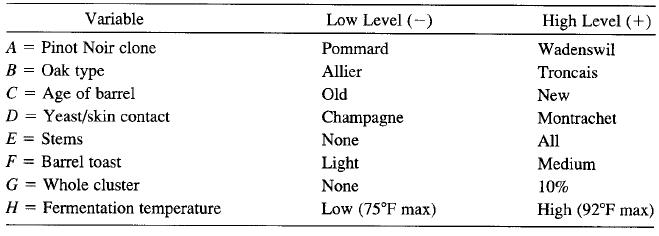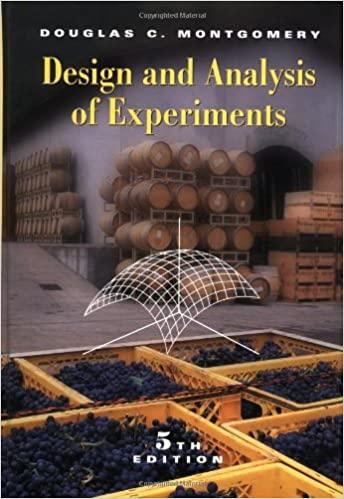Harry and Judy Peterson-Nedry (two friends of the author) own a vineyard and winery in Newberg, Oregon.
Question:
Harry and Judy Peterson-Nedry (two friends of the author) own a vineyard and winery in Newberg, Oregon. They grow several varieties of grapes and manufacture wine. Harry and Judy have used factorial designs for process and product development in the wine-making segment of their business. This problem describes the experiment conducted for their 1985 Pinot Noir. Eight variables, shown below, were originally studied in this experiment:

Harry and Judy decided to use a 28-4IV design with 16 runs. The wine was taste-tested by a panel of experts on March 8, 1986. Each expert ranked the 16 samples of wine tasted, with rank 1 being the best. The design and the taste-test panel results are shown in Table 8-31 on page 356.
(a) What are the alias relationships in the design selected by Harry and Judy?
(b) Use the average ranks (y) as a response variable. Analyze the data and draw conclusions. You will find it helpful to examine a normal probability plot of the effect estimates.
(c) Use the standard deviation of the ranks (or some appropriate transformation such as log s) as a response variable. What conclusions can you draw about the effects of the eight variables on variability in wine quality?
(d) After looking at the results, Harry and Judy decide that one of the panel members (DCM) knows more about beer than he does about wine, so they decide to delete his ranking. What affect would this have on the results and conclusions from parts (b) and (c)?
(e) Suppose that just before the start of the experiment, Harry and Judy discovered that the eight new barrels they ordered from France for use in the experiment would not arrive in time, and all 16 runs would have to be made with old barrels. If Harry and Judy just drop column C from their design, what does this do to the alias relation-ships? Do they need to start over and construct a new design?
(f) Harry and Judy know from experience that some treatment combinations are unlikely to produce good results. For example, the run with all eight variables at the high level generally results in a poorly rated wine. This was confirmed in the March 8, 1986 taste test. They want to set up a new design for their 1986 Pinot Noir using these same eight variables, but they do not want to make the run with all eight factors at the high level. What design would you suggest?
Step by Step Answer:






